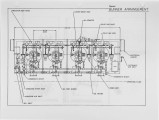| OCR Text |
Show The transport equation for enthalpy is solved using a conjugate heat transfer model, with radiative heat fluxes calculated by solving additional conservation equations in each component direction. Gas phase combustion is modelled as a one-step global reaction, with user speCified fuel and oxidant components reacting to form combustion products. Transport equations for the three gaseous species include a chemical reaction rate which is governed by either the mixing of the eddies or by an Arrhenius rate equation. The code uses an interactive second phase to solve the equations of motion and trajectory of a user specified particle or droplet, which is necessary when modelling the combustion and burnout of a non-gaseous fuel (e.g.-fuel oil). Droplet trajectories are computed by integration of a force balance which includes inertia and hydrodynamic drag. Modelling of the dispersed second phase includes rate expressions for particle heat-up, evaporation, and boiling: During heat-up, heat transfer is computed via a Nusselt correlation for the heating of a sphere. During particle evaporation, mass transfer from the particle to the gas phase is mass diffusion controlled. Once the user specifed droplet boiling point is reached, however, mass transfer is controlled by a vaporization rate constant which is dependent on the physical properties of the liquid and the surrounding medium. The interphase exchange terms are included in the gas phase calculations, so that the dissipation of the droplet trajectories is fully coupled into the converged flowfield. DEVELOPMENT OF BASE CASE A 3-dimensional model of the furnace radiant section was developed based on the geometry taken from the original boiler assembly drawings. The model employed a computational grid consisting of 13,860 cells. In order to achieve improved model accuracy per given computer CPU time, the grid was set-up to be non-uniform, with the largest number of cells positioned along locations of highest probable shear stresses (e.g.-burner throats, port entrances). In addition, the furnace's symmetrical design was exploited via the use of symmetry cells: These are 'slip walls' in which no shear is present and no flow can pass through. The walls act as mirrors, greatly reducing total computer computation time. An isosymmetric outline of the Base Case model, along with the liquid fuel trajectories, is shown in Figure 5a. Corresponding boundary conditions are listed in Tables 1 and 2. The Base Case model was set-up to simulate system performance based on a single port per burner deSign. Ports were designed for 50 feetper- second, and were located just less than half of the furnace length downstream from the burner throats (as discussed in the previous section). The firing rate was 66 MKB/burner, with the oil spray entering through a symmetrical TABLE 1 OIL DROPLET BOUNDARY CONDITIONS BASE CASE PARAMETER VALUE Particle size Distribution Rosin-Rammler Distri-bution with N = 2.S, Mean Diam= 100 microns Initial Particle Density SOPounds/Cubic Foot Volatility 100 percent Initial Temperature 220 F Vaporization Tempera-ture (initial) 230F Boiling Point 290 F Latent Heat of Vaporization 850 BTU/Pound Initial U Velocity Component SOOfps Initial V Velocity Component - SOO fps to + 600 fps Initial W Velocity Component - 600 fps to + 600 fps Mass Distribution Symmetrical |















